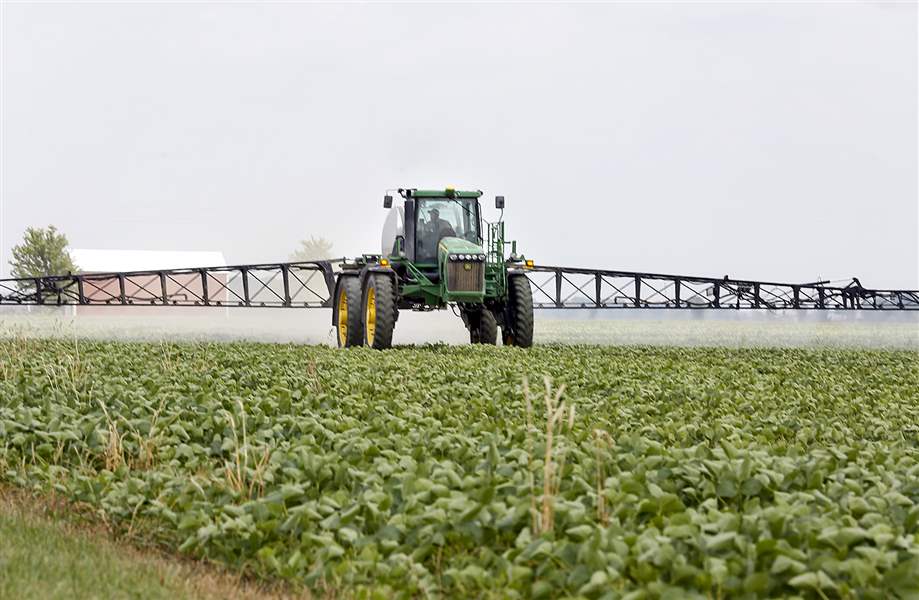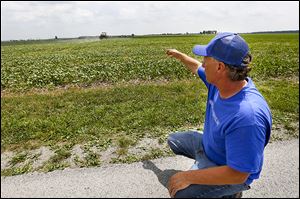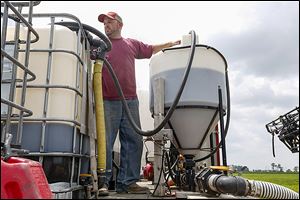
Local farmers go from waterlogged to bone dry
7/10/2016
Ben Brickner sprays soybeans on Drewes Farms Partnership in Custar, Ohio. Last year it was rain. This year, it’s been nearly droughtlike.
THE BLADE/AMY E. VOIGT
Buy This Image
When Richard Snyder drives past the fields of Fulton County, what he sees dredges up memories he’d rather stayed forgotten.
“It reminds me of 1988,” said Mr. Snyder, a farmer who grows corn, soybeans, and wheat in soil around Delta, Ohio, and Neapolis.
“It was a little more severe then than it is now. But we’re approaching it,” he said of the start of the two-year North American drought that ended up being one of the worst on record, causing $60 billion in damage and accompanied by withering heat that killed 17,000 people in the United States.
What he had hoped to see was a rebound from last year when farmers in northwest Ohio, southeast Michigan, the overall eastern U.S. Corn Belt suffered a double whammy from low-yield harvests caused by an overly wet spring and June, and lower grain prices because of an enormous corn crop in the western corn belt states.
But farmers and other agricultural experts say farmers in northwest Ohio and southeast Michigan could be hammered for a second straight year, this time by a wet planting season followed by droughtlike conditions.

Mark Drewes watches Ben Brickner, an employee, spray soybeans in a field in Custar. ‘I don’t want to sound like a complainer,’ Mr. Drewes said. ‘But we’ve been through a pretty challenging year this year after what happened last year.’
“I don’t want to sound like a complainer, but we’ve been through a pretty challenging year this year after what happened last year,” said Mark Drewes of Custar, Ohio, whose family farm grows corn, soybeans, wheat, and alfalfa in Wood, Henry, Putnam, and Hancock counties.
Matt Roberts, an agricultural economist at Ohio State University, said this season Ohio has been beset by “patchy” rainfall.
“You get pop ups occurring here and there. I’m certain there are some farmers who have had adequate moisture, but there’s many who haven’t,” he said.
Thursday night was a prime example.
In Lucas County, nearly three-quarters of an inch of rain fell at Toledo Express Airport in the western half of the county. Yet in Lake Township, just south of Toledo, rainfall at Toledo Executive Airport was just a tenth of an inch.
Around Delta near Mr. Snyder’s farm, the area received three-tenths of an inch that night, enough to moisten the ground but not enough to make a difference.
At Custar in Wood County, Mr. Drewes got excited when he heard rain might be coming. But he was only disappointed.
“We watched the storm on the radar. I thought we would get something — but nothing,” he said. “I’ve got a friend up in Metamora who got 2 inches of rain.
“Here, it continues. It’s dry. The corn is all rolled up tight and still dry.”
Weather stations in Hancock, Defiance, and Allen Counties also recorded no precipitation from the storms that swept through parts of northwest Ohio on Thursday.
“We did not get that blessing of rain. This area is still pretty dry. It’s a concern,” said Ed Lentz, Ohio State University agricultural extension agent for Hancock County.
“It’s been really patchy and you can tell the areas that got rain and those that didn’t,” Mr. Lentz said. A storm last week brought nearly five inches of rain to southwest Hancock County, the rest of the county got nothing.
“As the plants get bigger we’re all going to need that water,” Mr. Lentz said.
Likewise, rainfall has been scattered in Williams County.
OSU extension agent Florian Chirra said stormy weather rolled through the northern part of the county near Pioneer, but the southern part barely got wet.
“What we got, it’ll definitely help but it still isn’t going to change the yield,” Mr. Chirra said. The crop in Williams County will be average at best and still has the potential to be below average, the extension agent said.
He said the crops have lost some of what are usually good warm growing days because of the lack of rain, and now time has pushed on. “We’re starting the second week of July so it’s not going to be anywhere near a bumper crop,” he said. “It’s going to be an average yield on both corn and soybeans.”

Joshua Tschappat refills tanks at Drewes Farms Partnership.
Soggy summer of 2015
Last year, farmers had to deal with rainfall that was more than 300 percent of normal in some areas of Ohio, said James Banachowski, vice president and general manager of the grain group at The Andersons Inc.
That meant the crops weren’t all planted or fertilized, resulting in yields falling significantly to 153 bushels per acre. The year before, the yields were 176 bushels per acre.
Given the wet spring this year, the region’s farmers thought they would be facing a soggy repeat of last year, Mr. Drewes and others said. As a result, the planting plans changed very little.
Mr. Roberts, the agricultural economist, said about 3.55 million acres of corn were planted in Ohio this year and in 2015. State soybean acreage was 4.75 million last year and is 4.8 million this year. Winter wheat increased this year to 590,000 acres, up from 520,000.
“I think for Ohio [planting] likely was driven more by what they did not see in the relative prices. They just stuck with their rotations and didn’t really shift. ... They looked at those [commodity] prices, and they were not really excited either way.”
But no one anticipated this year’s random rainfall that has produced bone-dry conditions in some counties and flash floods in others, such as in Hardin County, Mr. Roberts said.
“I don’t think we’re yet at the point where there’s a tremendous amount of worry, but there certainly is drying out occurring,” Mr. Roberts said.
Some areas of Ohio and Michigan are lucky enough to have irrigation. In northwest Ohio, it is too expensive and few farmers have it, experts said.
Jim Swartz, grain manager at Luckey Farmers Inc. of Woodville, a grain marketing and farm supply cooperative that works with farmers in Wood, Sandusky, Lucas, and Ottawa counties, said some of the fields he has walked recently had ground with cracks 6 to 10 inches deep.
“These are optimal days for growing — and we’re missing them because of a lack of moisture,” Mr. Swartz said. “Last year we couldn’t stop the rain; this year we can’t get it started.”
There have been worse drought periods, 1988 being the worst. But 2016 is rising fast up the list, many say, even with Thursday’s rainfall.
Wood County’s OSU extension agent Alan Sundermeier said the corn and soybean fields that people drive by won’t look bad. But the crops are under stress just as both crops are reaching a critical stage.
In a week or two, corn plants will begin producing tassels — their pollen-producing flowers.
“You have to have pollination between the tassel and the ear silk,” Mr. Sundermeier said. “If it’s dry, the silk is not receptive to the pollen, or the silk simply dries out. Or it could abort the plant altogether.”
Soybeans are “just kind of dormant” but will bloom in about three weeks. They will need moisture to help form pods, Mr. Sundermeier said.
Not everything is gloomy.
This year’s wheat crop in northwest Ohio was strong with high yields. Unfortunately, wheat prices have been falling since last week on the commodity markets.
“Everybody was hoping to get $5.50 [per bushel] out of it, and you’re lucky if you can get $4.50 now,” Mr. Snyder said.
However, the bigger concern right now is the future of this year’s corn and soybean crop, he said.
“If we go through pollination without water we’re looking at severe damage,” Mr. Snyder said.
“In northwest Ohio and southeast Michigan I’m certain we could end up with a really short crop of corn and soybeans. ... I’ve got some guys I deal with in the seed business and this could be the nail in the coffin for them,” Mr. Snyder said.
Contact Jon Chavez at: jchavez@theblade.com or 419-724-6128.